Walking through a woodland ride with my dog the other day I suddenly came face to face with a huge dragonfly! It was a magnificent Southern Hawker (Aeshna cyanea). Apparently, the males of this species are known for being inquisitive – if you stop to admire one, he may very well hover up close to get a better look at you!
August favourites!
One of the things I find exciting about dragonflies is that they were amongst the first insects to evolve on Earth, around 300 million years ago. That’s even before the dinosaurs. Back then the oxygen level in the atmosphere was much higher than today, and this allowed them to grow into giants, with a wingspan of up to 2.5 feet!
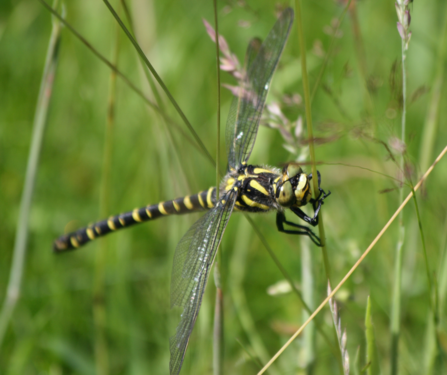
There are 36 species of dragonfly in the UK and 21 of their more diminutive cousin, the damselfly. Many of them can be found in Somerset and Westhay National Nature reserve is an ideal place to spot them! For example, it is home to the Emperor dragonfly (Anax imperator), one of the largest dragonflies in Europe. It has a wingspan of around 10 cm - not as big as its ancestors, but still impressive by today’s standards!
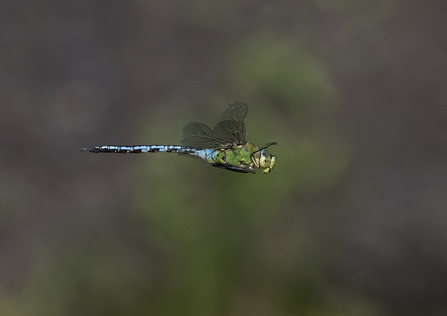
Emperor dragonfly © Chris Lawrence
Dragonflies and damselflies are generally on the wing from mid spring until late summer, patrolling woodland rides, hedgerows and waterways. A quick way to tell them apart is to remember that dragonflies hold their wings out roughly at right angles to their body when at rest, while damselflies close their wings together behind their body.
They are both ferocious hunters of other smaller insects, like gnats, mosquitos and butterflies. Dragonflies especially have evolved into super aerobatic flyers in order to out manoeuvrer their prey: their four wings can beat together or separately, allowing them to turn quickly, hover and even fly backwards. Damselflies tend to flutter in flight, but they both have excellent vision: their huge compound eyes are made up of thousands of tiny lenses that enable them to detect the slightest movement from any direction.
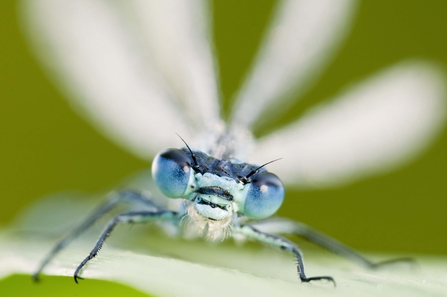
©Ross Hoddinott/2020VISION
One of the delights of wandering through the countryside in August is the endless supply of blackberries - I’m usually munching as I go! These delicious fruits are also one of the many ways in which wildlife benefits from the humble bramble (Rubus fruticosis). It can grow just about anywhere, from woodlands to moorland, coastal cliffs and waste ground. Its arching thorny stems can grow up to 3 inches a day in the summertime, creating dense bushes that provide valuable protection for nesting birds, hedgehogs, hazel dormice (Muscardinus avellanarius) and even grass snakes (Natrix helvetica).
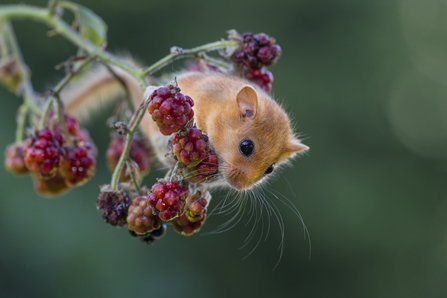
AdobeStock
Bramble flowers bloom pink or white from July into August, providing nectar for a wide variety of insects, including butterflies and bumble bees. Song thrushes (Turdus philomelos), foxes and badgers are all known to enthusiastically eat up the berries and deer will also graze the leaves – despite the thorns!
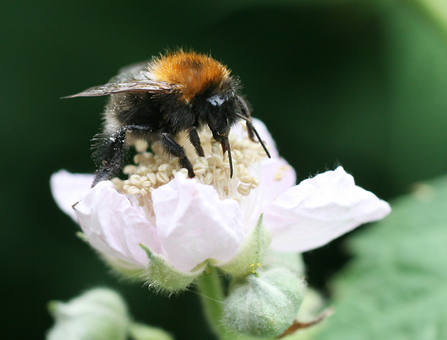
Tree Bumblebee ©Penny Frith
Blackberries are high in vitamin C so we have every excuse to enjoy them in a blackberry and apple crumble! They have also been used in the past as a natural remedy, along with the leaves, for a variety of ailments.
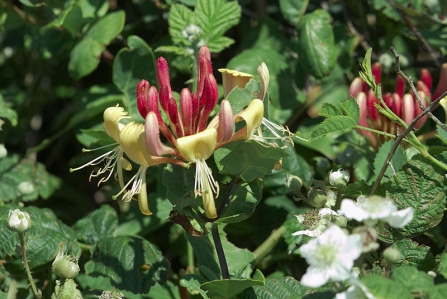
Honeysuckle - ©northeastwildlife.co.uk
Another wildlife hero gracing woodlands and hedgerows is honeysuckle (Lonicera periclymenum). It's a climber, twisting its long stems around the branches of trees and shrubs as it grows upwards towards the light, which has also earnt it the name ‘woodbine’. Its nectar-rich flowers are tubular in shape and a delicate mix of cream, yellow and pink as they unfurl throughout the summer. Their sweet heady scent is strongest in the evening, making honeysuckle not only a favourite amongst gardeners, but also irresistible to pollinating moths - most famously the stunning elephant hawk-moth! In turn, these moths are preyed upon by opportunistic bats.
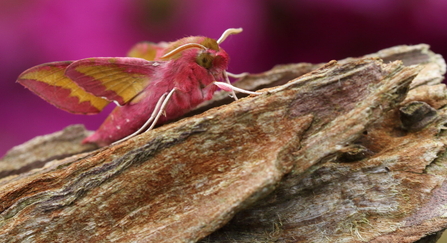
Image: Vaughn Matthews
During the day the sweet nectar is relished by bumbles bees and butterflies - the increasingly rare White Admiral butterfly (Limenitis camillarelies) relies upon it especially.
White admiral ©Tom Hibbert
Blackfly gather on new honeysuckle shoots and these are food for blue tits and other insects like ladybirds. Its winding stems also provide nest sites and material for birds and dormice. Dormice also rely on the flowers for a nectar-rich drink which is high in energy!
In autumn its juicy red berries are quickly snapped up by song thrushes, warblers and bull finches (Pyrrhula pyrrhula) amongst others, and squirrels are partial to them too!
As dusk approaches, you might be lucky enough to see a mother hedgehog escorting her young on a foraging expedition through your neighbourhood! Hedgehogs (Erinaceus europaeus) usually give birth to a litter of four or five ‘hoglets’ (sometimes as many as seven!) in June or July.
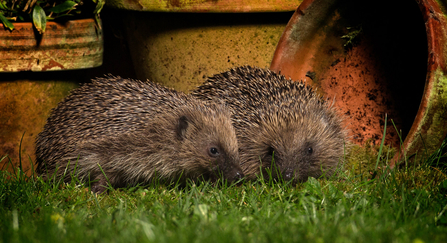
Photo: Jon Hawkins – Surrey Hills Photography
Hoglets leave the nest when they are 3 to 4 weeks old and accompany their mother on her nightly excursions, learning what’s good to eat and where to find it. Hedgehogs eat all kinds of invertebrates (that is any creature without a backbone) and they are especially fond of big, crunchy beetles and earthworms. They will also eat amphibians like frogs.
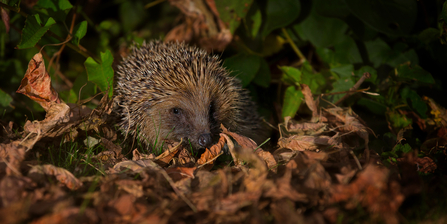
Hedgehog © Jon Hawkins - Surrey Hills Photography
After learning the ropes for a week or so, hoglets will head off on their own. However, hedgehogs have a rough start in life: generally, mothers will only wean two or three of their offspring successfully. If they have a second litter in the autumn, these youngsters are unlikely to survive as there is little time to put on enough weight for winter hibernation. It is not uncommon to see young hedgehogs still searching for food even during the daytime in winter.
If they survive to adulthood, hedgehogs can live for 2 to 3 years, and their superpower is their prickles! The prickles are modified hairs which they can raise using powerful muscles along their back to protect them from predators when they roll themselves up into a tight little ball.
Although they’re mostly nocturnal, hedgehogs are not discreet! They can be heard snuffling loudly in search of supper long before they’re visible. And when daylight comes, you may find a little ‘calling card’ left on your grass: a couple of medium-sized black droppings full of bits of insect!
Despite being one of our best loved animals, hedgehogs are in trouble. They are listed under the IUCN Red List for British Mammals as ‘vulnerable to extinction’. Research is ongoing as to the reasons for their decline, but fragmentation of habitat is considered a major contributor: fences, walls, roads and new developments all prevent them from moving between green spaces in search of food, a mate and a safe place to shelter.
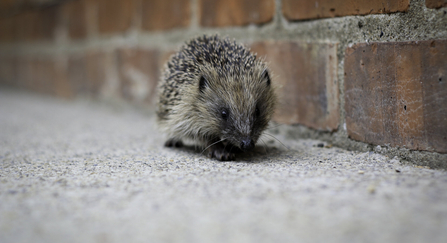
Image: Tom Marshall, WildNet
However, our gardens can still be a lifeline, providing a smorgasbord of hedgehog delicacies, a shallow dish of fresh water in hot weather and shelter in the daytime underneath bushes and shrubs. In November, the spaces under our sheds and compost heaps, or even small piles of logs, can perfectly accommodate a hedgehog 'hibernaculum' – a nest of leaves where they can safely hibernate until April.
Hedgehog. Image: Gillian Day
If you would like to learn how to build a hedgehog home or how to make your neighbourhood more hedgehog friendly, follow the link here.




